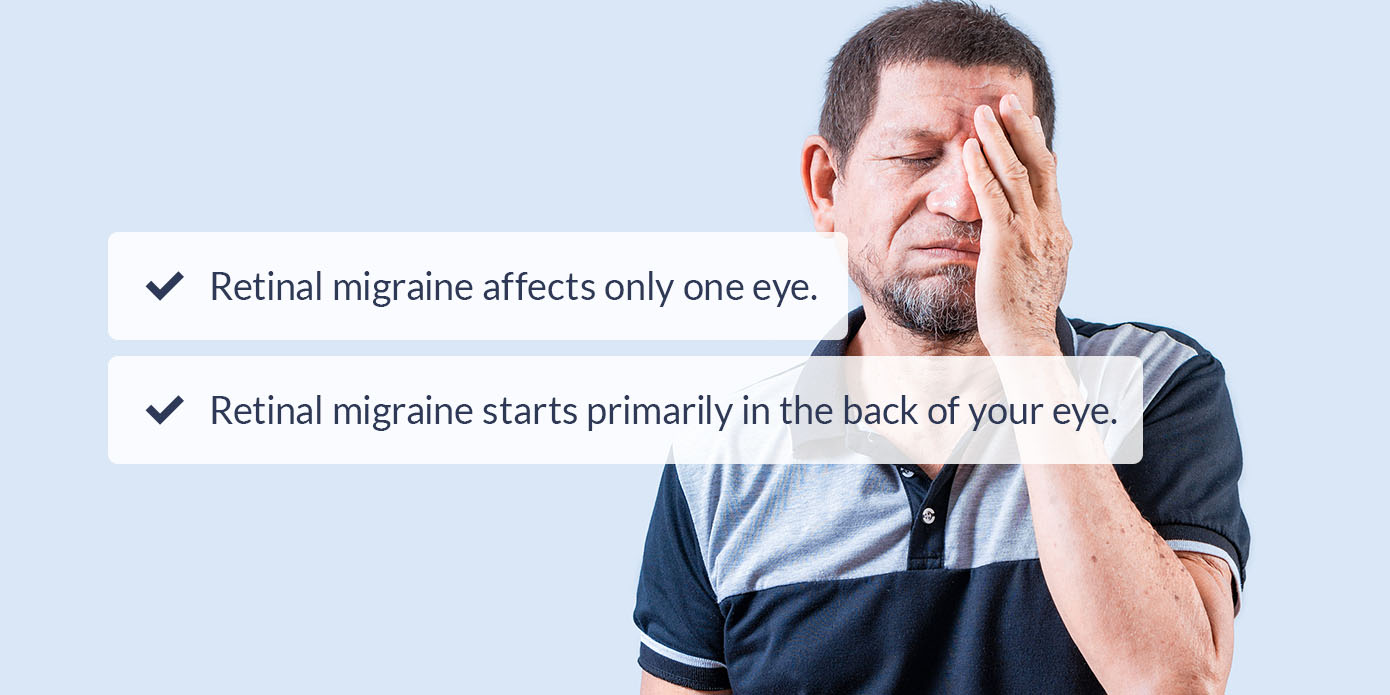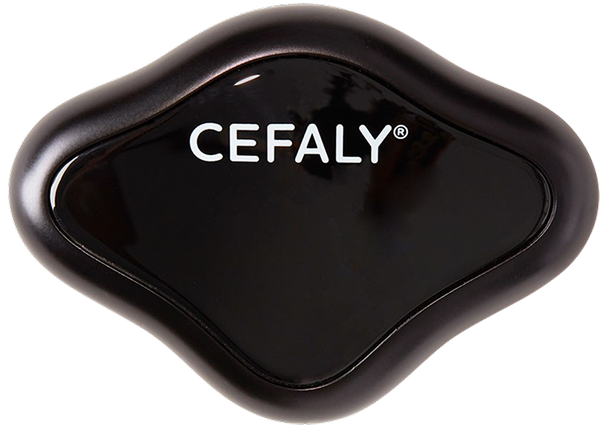If you have visual disturbances in one eye and a migraine attack that follows or accompanies the visual symptoms, then you might be experiencing a retinal migraine. This disorder is rare and can be challenging to treat since common migraine medications aren’t typically recommended. CEFALY is a drug-free treatment option that’s clinically proven to provide migraine relief.
Learn more about the signs of retinal migraine, causes and potential treatment options.
What is a retinal migraine?
Retinal migraine is a rare disorder that causes visual disturbances and a painful migraine attack. It’s typically a monocular condition, meaning it only affects one eye. These conditions are also defined as transient monocular scotoma because they cause a temporary loss of vision or an impact on vision on one side of the eye.
One of the key symptoms of this type of migraine is visual disturbances in one eye that’s typically followed by a headache. Sometimes, the migraine headache can also occur before the retinal attack.
The visual symptoms of retinal migraine may include:
- Temporary loss of vision
- Scotoma — blind spots or areas of impaired vision
- Scintillations — seeing stars or twinkling lights
With retinal migraine, these symptoms happen repeatedly and typically last for 10 to 20 minutes before your vision returns to normal. In most cases, the attacks start in the same eye.
What causes retinal migraine?
A retinal migraine can be a sign of many things, but it usually starts with symptoms that affect the back of your eye. The blood vessels in this area become narrowed, causing the retina to convert the electrical signals you see into abnormal messages. This miscommunication is what causes the visual distortions and the migraine attack.
There is no singular cause for retinal migraine, but it can be caused by some of the triggers for migraine with aura, which include:
- Stress
- Bright lights
- Dehydration
- Sleep changes
- Smoking
- Low blood sugar
- Birth control pills
- High blood pressure
Migraine triggers are different for everyone. It’s best to avoid common triggers like alcohol and caffeine or certain foods that cause your migraine attacks. The most important thing when dealing with migraine is to identify symptoms and never try to ignore or power through the symptoms, because they may get worse.
Difference between retinal migraine and other migraine types
Retinal migraine is different from other forms of migraine because it starts primarily in the back of your eye. Unlike other migraine attacks, which occur in phases, retinal migraine doesn’t typically have a prodrome, aura, attack and post-attack phase. The visual changes can come on suddenly.

Retinal migraine is commonly confused with migraine with aura. Both these migraine types cause visual distortions with symptoms like flashing and shimmery lights in your vision. So, how can you tell the differences between the two to identify which migraine type you have?
The main difference is that migraine with aura affects both eyes while retinal migraine affects only one eye. The visual distortion with retinal migraine is also more severe than that of an aura migraine.
Another key difference is that migraine aura doesn’t happen with every episode, but with retinal migraine, it happens with every attack.
Retinal migraine diagnosis
There isn’t currently a test for retinal migraine. Doctors will typically rule out other possible causes for the visual disturbance. They may also check for eye diseases and review your personal and family medical history.
Physicians also consider age when diagnosing retinal migraine. If someone under the age of 50 with no risk factors for other diseases, like heart disease, has a visual disturbance that lasts less than an hour and is accompanied or followed by a migraine headache, retinal migraine is likely the diagnosis.
Get Drug-Free Migraine Relief With CEFALY
Shop Now
90-day money back guarantee
FDA-cleared
financing available
Treatment options for retinal migraine
If you have retinal migraine, your doctor may suggest painkillers like acetaminophen or ibuprofen. They may also recommend migraine preventive medication like topiramate or amitriptyline. If the treatment option doesn’t help relieve or reduce your migraine, your physician may refer you to a neurologist for further testing.
A combination of aspirin-containing analgesics, acetaminophen and caffeine is typically prescribed for first-line abortive treatment. However, frequent use of medication, especially combination painkillers, can have adverse effects and even trigger a rebound headache.
The CEFALY wearable device is another treatment option for those who prefer drug-free solutions. This FDA-cleared medical device uses neuromodulation therapy to prevent and relieve migraine headaches. It comes with two main settings:
- PREVENT: This 20-minute setting is meant for daily use and is clinically proven to help lower migraine frequency and severity. It uses low-frequency signals to gradually desensitize the trigeminal nerve, which is the primary pathway for migraine pain.
- ACUTE: This 60-minute setting gets to work at the first sign of a migraine attack. It uses high-frequency external trigeminal nerve stimulation (eTNS) to block pain signals directly in the main pathway related to headache pain.
Management strategies for retinal migraine
Since retinal migraine attacks are typically short-lived, abortive therapy is typically not recommended. Common migraine medications like beta-blockers are typically avoided in migraine with transient vision loss.
Retinal migraine treatment is largely focused on prevention. It’s about understanding, tracking, preventing and promptly addressing the symptoms. It’s important to track your migraine attacks to prevent them from getting severe and reduce their frequency. Pay special attention to potential triggers like excessive blue light or certain foods.
The CeCe Migraine Management app is an easy way to track your migraine triggers and symptoms. It can help you log your migraine attacks and show how the symptoms evolve over time. You can also pair the app with the CEFALY Connected migraine treatment device to monitor your treatment session and see your progress in real time.

Try CEFALY for drug-free migraine treatment
Retinal migraine can be difficult to deal with, especially since common migraine medications are not typically recommended. Prevention and immediate action are key to reducing the severity and frequency. At CEFALY, we understand the importance of finding a treatment option that works for you.
CEFALY is the #1 FDA-cleared migraine treatment device that’s clinically proven to provide relief. It’s a dual-purpose device that treats migraine attacks when they happen and prevents future episodes. You don’t need a prescription to use this device and it’s the most affordable neuromodulation migraine treatment.
If you want a drug-free treatment option for migraine, try CEFALY today for a 90-day, money-back guarantee.
CEFALY is specifically indicated for the acute treatment of migraine with or without aura and the preventative treatment of episodic migraine. Its effectiveness for treating retinal migraine has not been studied. If you have retinal migraine and want to use CEFALY, talk to your healthcare provider. Our 90-day guarantee means you can try CEFALY risk-free! Use the device as directed and if it doesn’t work for you, you may return it within 90 days of purchase.













